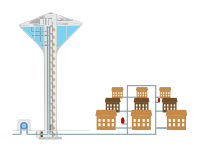
Photo from wikipedia
The water distribution network (WDN) is usually the final physical barrier preventing contamination of the drinking water before it reaches consumers. Because the WDN is at the end of the… Click to show full abstract
The water distribution network (WDN) is usually the final physical barrier preventing contamination of the drinking water before it reaches consumers. Because the WDN is at the end of the supply chain, and often with limited online water quality monitoring, the probability of an incident to be detected and remediated in time is low. Microbial risks that can affect the distribution network are: intrusion, cross-connections and backflows, inadequate management of reservoirs, improper main pipe repair and (or) maintenance work, and biofilms. Epidemiological investigations have proven that these risks have been sources of waterborne outbreaks. Increasingly since the 1990s, studies have also indicated that the contribution of these risks to the endemic level of disease is not negligible. To address the increasing health risks associated to WDNs, researchers have developed tools for risk quantification and risk management. This review aims to present the recent advancements in the field involving epidemiological investigations, use of quantitative microbial risk assessment (QMRA) for modelling, risk mitigation, and decision-support. Increasing the awareness of the progress achieved, but also of the limitations and challenges faced, will aid in accelerating the implementation of QMRA tools for WDN risk management and as a decision-support tool.
Journal Title: Canadian Journal of Civil Engineering
Year Published: 2019
Link to full text (if available)
Share on Social Media: Sign Up to like & get
recommendations!